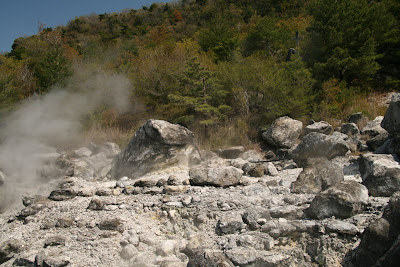We felt slightly underdressed...
Of course most of our activities in Hiroshima centered around sites commemorating the dropping of the atomic bomb. I have to say that seeing the mangled “a-bomb dome,” pictures of twisted buildings and suffering children, and fragments of bloodstained clothing affected me far more than all of the war related sites I had seen in Europe. Visiting Dachau concentration camp, it was easy enough to look on as an outsider—“I had nothing to do with these atrocities,” I could tell myself. “The Nazis were evil, and the Jews were innocent.” It was, so it seemed, black and white. In Hiroshima and Nagasaki, it was my country that was to blame. I didn’t want to speak English; I felt like people were staring at me, even if there were many other tourists there.
The A-Bomb Dome
Of course I have heard the arguments: dropping the bomb[s] ended the war and ultimately saved lives. Does that really justify it? I can’t help but be disgusted at the selfishness of the Japanese imperialism that led to the war; while the government had grandiose plans to conquer the world, it was the schoolchildren who were out clearing firebreaks on August 6 who bore the brunt of the bomb attack. Still, I can’t help but be even more disgusted by the actions of my own country, which hastily completed the a-bomb attack—its science experiment and power display on behalf of the Soviets—at a time when the Japanese were already considering surrender. (Yes, I did in fact see American documents at the museum which taught me such things. We were never taught this in American schools.)
Most people don’t talk about the war in Japan; they are too ashamed to do so, and they are afraid to stir up hatred. Why aren’t we ashamed too? I can be disgusted and ashamed, but what makes this truly painful is that it concerns people from my home country and the country I have come to love as my home. I have met WWII veterans in the US, and I probably have met some in Japan, too. These are people whom God loves. These are people who collectively chose to follow their sinful human nature and wage war on each other.
I was overwhelmed by the sinfulness of humankind and our need for redemption. The Hiroshima peace museum offered empty John Lennon style “give peace a chance” solutions: if everyone agrees that we need world peace, then the world will be saved. Thousands of letters of protest from the mayors of Hiroshima to ambassadors of various countries on the occasion of each atomic test adorned the walls. I admire their diplomatic and commemorative efforts, but they lack in that they do not acknowledge one simple fact: "None is righteous, no, not one; no one understands; no one seeks for God. All have turned aside; together they have become worthless; no one does good, not even one. Their throat is an open grave; they use their tongues to deceive. The venom of asps is under their lips. Their mouth is full of curses and bitterness. Their feet are swift to shed blood; in their paths are ruin and misery, and the way of peace they have not known. There is no fear of God before their eyes” (Romans 3:11-18). There can be no explanation for war without an understanding of human sinfulness, and there can be no world peace unless everyone in the world knows the peace of Christ in their own hearts.
After we finished at the peace museum, we wandered into a garden fair with a large display of bonsai trees, among other things. There was also a booth selling an excellent selection of pickles; we sampled each kind. It was refreshing to spend some time admiring the beautifully rebuilt city and to bask in some of the goodness with which God has blessed the nation of Japan.
Later that day, we went on to Nagasaki, where we met up with our friend, Stephanie, who recently moved to Kyushu. We saw the Nagasaki atomic bomb museum as well, and I liked (if liked is the right word) that museum more than the Hiroshima museum, because of its clear message that war (and specifically the atomic bomb) hurts everyone—in this case, Christians, Buddhists, Japanese, Korean forced labor, Allied prisoners of war, civilians, and military. One display featured objects taken from the ruins of the Urakami Cathedral, which had been the largest church in Asia. The church and the worshippers inside were destroyed.
Melted rosaries from the Urakami Cathedral
Nagasaki was the birthplace of Japanese Christianity in the sixteenth century, and the site of some of the most intense persecution when Christianity was illegal, between the 1590s and 1871. We visited the site where in 1597 twenty-six Japanese and Portuguese Christians were crucified, as well as the nearby town of Shimabara, where 37,000 Christians were killed in an uprising, and the onsen resort town of Unzen, where Christians were tortured in the boiling sulfur hot springs, in an area known as 地獄 (jigoku), meaning hell. Ironically, we enjoyed bathing in the slightly-less-hot onsen baths…
The memorial to the 26 martyrs in Nagasaki
Unzen "Jigoku"--can you find the cross in remembrance of the Christians who died here?
Foot bath in Shimabara. This is the closest you will get to seeing a picture of an onsen.
Okay, that’s it for part 2. I promise part 3 will be less death-oriented.









No comments:
Post a Comment